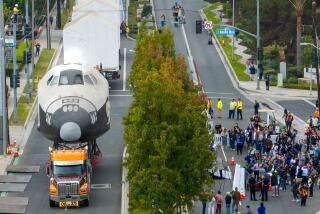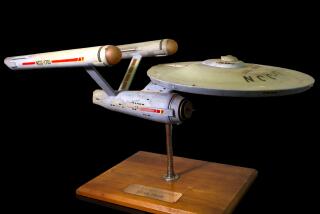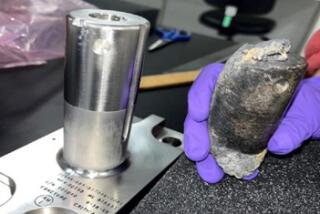Challenger Debris Is Still Trickling In : Space: Most of what is sorted is ocean junk--chunks of unmanned rockets or other flotsam and jetsam. But occasionally, the real thing turns up.
CAPE CANAVERAL, Fla. — Almost every month, Kennedy Space Center gets a call from people who believe that they may have found a piece of Challenger. Six years after the nation’s worst space disaster, the searching and sorting of debris go on.
Most of what is sorted is ocean junk--chunks of unmanned rockets or other flotsam and jetsam. But occasionally, the real thing turns up.
Early last year, fishermen found a small tank and a metal fragment a few feet long in the Atlantic Ocean off Cape Canaveral.
The articles are locked in a holding area, awaiting burial in the abandoned missile silos that hold a quarter-million pounds of Challenger remains.
“I think it’s about over. I don’t think we’re going to see much more,” said Elliott Kicklighter, who is in charge of the National Aeronautics and Space Administration’s crypt. “It hasn’t been a very busy job, thank goodness.”
The two 90-feet-deep silos have been opened only three times since the bulk of the shuttle was buried in 1987. Ten-ton concrete caps cover the silos, which are surrounded by a chain-link fence at Cape Canaveral Air Force Station.
Only hardware is in the silos; all 5,000 pieces are catalogued. The remains of the seven astronauts killed in the explosion and their personal effects were turned over to their families long ago.
For the first few years after the accident, Kennedy security officers tracked down reports of illegally held debris, considered government property. No charges were filed, although some people surrendered the items with reluctance, said Calvin Burch, the space center’s chief of security.
Now, most of the detectives’ time is spent checking objects found by fishermen and beachcombers.
Just a few weeks ago, officers received several chunks of lightweight aluminum, a spring coil and a piece of hard, black plastic in the shape of a half-moon that had been found on a beach 30 miles south of the space center. The discoverers thought maybe the articles had come from Challenger.
They hadn’t.
“It had nothing to do with the shuttle program at all,” Burch said.
Burch isn’t surprised by the public’s lingering preoccupation with Challenger.
“It’s still, I think, in the minds of people that that event occurred,” he said.
Americans watched in horror six years ago Jan. 25 when the Challenger exploded in a ball of flames 73 seconds after liftoff. The time was 8:39 a.m. PST.
Almost immediately, Coast Guard ships began searching the Atlantic for shuttle remains. Hundreds of pounds of metal was salvaged the first day.
The remains of the astronauts were found in March in the debris of the crew cabin. The dead included schoolteacher Christa McAuliffe, the first private citizen to be sent into space.
By the time the search ended late that summer, several hundred thousand pounds of shuttle debris had been recovered, including the failed booster components. A leak in a joint on the right solid rocket booster was blamed.
About 9,000 people took part in the search, the most comprehensive underwater hunt ever conducted. They covered more than 90,000 square miles of ocean by air and sea, using sonar to identify anything bigger than a coffee cup.
Ed O’Connor, a retired Air Force colonel who directed the search, said the team located more than 90% of the spaceship. Only the critical pieces were retrieved. The rest--half the orbiter and boosters, two-thirds of the external fuel tank and a fourth of the satellite payload--was left at sea.
O’Connor said only a remote chance exists that any of those components, some in 1,000 feet of water, could wash ashore.
More to Read
Sign up for Essential California
The most important California stories and recommendations in your inbox every morning.
You may occasionally receive promotional content from the Los Angeles Times.










